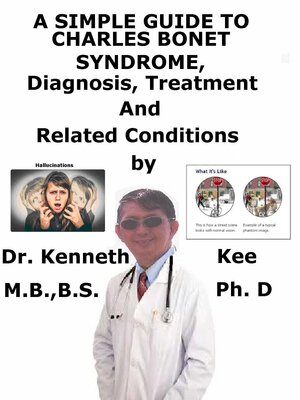A Simple Guide to Charles Bonnet Syndrome, Diagnosis, Treatment and Related Conditions
ebook
By Kenneth Kee

Sign up to save your library
With an OverDrive account, you can save your favorite libraries for at-a-glance information about availability. Find out more about OverDrive accounts.
Find this title in Libby, the library reading app by OverDrive.



Search for a digital library with this title
Title found at these libraries:
| Library Name | Distance |
|---|---|
| Loading... |
This book describes Charles Bonnet Syndrome (Visual Release Hallucinations), Diagnosis and Treatment and Related Diseases
Charles Bonnet Syndrome is a not well known disorder and often misdiagnosed for other illnesses.
Charles Bonnet Syndrome (CBS) is a disorder in which a person with partial or complete vision loss (partial or total blindness) develops complex visual hallucinations.
The complex hallucinations linked with Charles Bonnet Syndrome normally comprise small animated (cartoon) images or faces.
CBS or Visual Release Hallucinations is relatively frequent among the visually-impaired
The affected patients are normally aware that the hallucinations are not real.
The frequency of visual hallucinations differs from one person to another.
Some may feel the hallucinations intermittently while others feel them daily or continuously.
These hallucinations are occasionally called 'phantom images' or 'phantom vision'.
These phantom images correlate to a person's usual visual experience.
The hallucinations patients with CBS feel can be portrayed as simple or complex.
Simple hallucinations comprise shapes and patterns while complex hallucinations comprise images of people, vehicles, animals, and plants.
Hallucination episodes can vary from a few seconds to hours and may repeatedly happen over the course of several days to years.
Most people who have Charles Bonnet syndrome have very poor vision but the Charles Bonnet syndrome can also affect people who have only a slight loss of vision or even normal vision.
The most common risk factors for developing Charles Bonnet Syndrome cause either central or peripheral vision loss:
Age-related macular degeneration
Glaucoma
Cataracts
Diabetic retinopathy
Retinitis pigmentosa
Optic neuritis
Retinal vascular occlusion
Stroke
Doctors believe the brain creates fantasy pictures or releases old pictures that are kept there to compensate for not getting images through the eyes.
There are 2 principal methods of contracting Charles Bonnet syndrome:
The result of a wide range of eye diseases - more frequent
The result of other medical disorders (e.g., stroke) or various eye procedures - Less frequent.
The hallucinatory images often happen with natural objects observed with the remaining vision.
The person might be diagnosed with Charles Bonnet syndrome if the person has:
Vision impairment
Complex visual hallucination or phantom images recently
Known what the person saw was not real (i.e., no delusions)
Knowledge that the person is not mentally ill
No noticeable issues with thinking or memory.
Not have hallucinations involving other senses, such as the hearing.
The images are solely visual (i.e., hallucinations cannot be heard, smelled, tasted or touched)
There is no known curative treatment for Charles Bonnet syndrome.
Doctors have tried medicines but they did not work.
Symptoms often improve with time, possibly because the brain becomes used to receiving fewer images to process.
However it may take years for the hallucinations to stop
The treatment measures for Charles Bonnet Syndrome may involve:
Treating the underlying cause of vision loss such as age-related macular degeneration, cataract, glaucoma, etc.
Vision aids to improve existing vision
Providing patient reassurance and emotional support
Administration of anti-epileptic or anti-anxiety medications, as needed
The restoration of vision has been shown to reduce or eliminate the visual hallucinations from Charles Bonnet Syndrome, in some...







